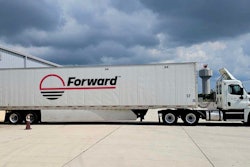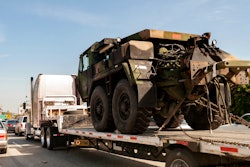Negotiations between representatives of the International Longshoremen’s Association and the USMX port ownership group to prevent a potential strike at ports along the East and Gulf coasts are set resume on Tuesday.
ILA members went on strike last October disrupting the flow of cargo and goods over those docks. The short-lived strike ended after Biden Administration officials helped broker a tentative deal that raised the base hourly rate to $63 from $39 over six years, an increase of 62%. The two sides agreed to extend the labor contract, with ILA members agreeing to go back to work through January 15, meaning a new strike could occur.
[RELATED: Port strike creates 'opportunities' for spot market carriers]
In December, President-elect Donald Trump voiced his support behind the ILA workers, saying that automation threatens job opportunities.
“A short strike is very likely given that the new administration won’t be sworn in until five days after the strike deadline,” said Dean Croke, principal analyst at DAT Freight and Analytics.
However, Croke pointed out that the question remains whether the Trump Administration can or will do anything to intervene between January 15 and Inauguration Day.
Cybersecurity concerns
In a piece on their website, the ILA union outlined their arguments against automation, a key issue in the strike. It listed previous points: automation is unnecessary because human-operated equipment performs just as effectively while protecting the jobs of port workers.
A new concern raised by the ILA focuses on cybersecurity risks. They argue that automated systems are vulnerable to hacking, stating “Imagine if a foreign adversary, like China, exploited these vulnerabilities and hacked our port systems. With ports increasingly dependent on automation and green energy technologies, an attack could cripple the U.S. economy overnight.”
Joe Ohr, COO of the National Motor Freight Traffic Association, commented on the need to embrace digital transformation to remain competitive and resilient.
“However, innovation comes with responsibility,” he said. “A secure and resilient supply chain is critical for ensuring the seamless movement of freight. This requires robust security measures, regular risk assessments, and a commitment to fostering a culture of cyber-awareness while implementing best practices."
USMX’s own statement insisted that port modernization is necessary and will allow for improved efficiency and increased cargo, thereby creating more jobs, better safety standards, and higher wages.
Contingency measures
To prepare for possible labor disruptions, Paul Brashier, vice president of global supply chain for ITS Logistics, advised investing in a multi-port tracking functionality.
“When containers are diverted to ports outside of network it is important to have visibility to where they are and plan procedures to get them out of terminals to avoid demurrage charges," he said.
If rerouted, Brashier said you should also have the right capacity and infrastructure in place to operate in those markets.
“Registering drivers and positioning equipment in those diverted markets will get containers out of affected areas and avoid excessive additional charges,” he added.
[RELATED: Affected carriers turn to contingency plans as port strike ensues]
Shippers are being urged to clear loaded containers and roll-on/roll-off equipment/cars from docks and return empties as soon as possible, Croke said. “Dray carriers should be adding capacity to major ports to assist shippers in this regard. Flatbed and auto haulers should do likewise to assist shippers with cars, trucks and machinery.”
Erik Rosica, sales supervisor for OEC Group, said that carriers and truckers should work with their clients to see what containers are planned to arrive over the next week. “Steps should be taken to pick up every container possible and prepull any that are cutting it close to make sure goods can get into customers warehouse and not stuck at the port.”
He added, “While demurrage and detention fees might be postponed in the event of a strike, if customers goods are stuck in container yard, that could cripple their supply chain. If the strike goes on for an extended period of time and customers goods are stuck, they might not be able to restock.”
Potential impact
If a disruption does push through, Croke said that imports represented roughly 10% of truckload demand at the port level. However, their downstream impact is more significant as these goods feed into other manufacturing processes.
“There is still ample truckload capacity in the market so I doubt a short strike of less than a week will have any impact on spot rates,” Croke said. “The current polar vortex is more likely to have a bigger impact like it did last year when rates jumped $0.12/mile mid-January.”
While a short three-day strike may have limited impact on the economy, a potential longer-term strike could have significant impact.
Smaller carriers already under financial pressure would feel the burden, Croke said, adding that it could potentially lead to more carrier exits if the strike extends into multiple weeks.
Croke said the greatest impact of a prolonged strike would likely fall on the automative sector, affecting major car manufacturers as well as agriculture and construction machinery OEMs preparing to ship cargo ahead of the seasonal March peak on the East Coast. This peak aligns with planting, building, construction, nursery, and produce seasons.
Greg Speier, Transportation Industry Group partner at Reed Smith, noted that perishable items would take the initial hit, followed by sectors involved in goods, materials, energy, agricultural and automobile, among others.
“The threat of a prolonged strike – or a strike itself – increases costs across the supply chain. The U.S. consumer will eventually bear the consequences,” Speier said. "This is not something Trump wants to deal with during his first week in office, and it would not surprise me if individuals on Trump’s behalf are currently working the phones to apply pressure to secure a deal.”














